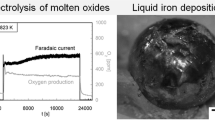Abstract
Some unsupported iron-zirconium oxide catalysts have been prepared by the calcination in air of precipitates containing 15 mole % iron. The catalyst formed at 500°C was shown by powder X-ray diffraction to consist of a non-equilibriated solid solution of iron(III) in a tetragonal or cubic zirconium dioxide structure whereas the catalyst formed at 1000°C was found to contain a zirconium-doped α-iron(III) oxide, or a magnetically ordered iron-zirconium oxide, in combination with an iron-containing monoclinic polymorph of zirconium dioxide. The57Fe Mössbauer spectra recorded in situ following the pretreatment of the solids in nitrogen, carbon monoxide and hydrogen showed that little change is induced in the catalysts under such conditions. The57Fe Mössbauer spectra also showed that the pretreated catalysts were unchanged by exposure to a 1:1 mixture of carbon monoxide and hydrogen at 270°C and 1 atmosphere pressure but were partially converted to iron carbide when used for the hydrogenation of carbon monoxide at 330°C and at 20 atmospheres pressure. The hydrocarbon product distribution showed Schulz-Flory α-values of 0.73 to 0.76 which were higher than the α-values obtained from pure iron catalysts which had been prepared and pretreated in a similar fashion. The57Fe Mössbauer spectra and the results of the catalytic evaluation may be associated with an interaction between zirconium(IV) and the electron-rich atoms of the reactant carbon monoxide.
Similar content being viewed by others
References
F.J. Berry, M.H. Loretto and M.R. Smith, unpublished results.
T. Jin, H. Hattori and K. Tanabe, Chem. Lett. (1981) 1533.
J. Gaube, G. Hochstadt, B. Schliebs, G. Sudheimer, Bundesministerium Fur Forschung und Technologie Forschung's bericht T, (1982) 148.
F.J. Berry and M.R. Smith, unpublished results.
J.P. Reymond, P. Meriaudeau and S.J. Teichner, J. Catalysis 75 (1982) 39.
R.A. Dictor and A.T. Bell, J. Catalysis 97 (1986) 121.
G. Le Caer, J.M. Dubois and J.P. Senateur, J. Solid State Chem. 19 (1976) 19.
G.B. Raup and W.N. Delgass, J. Catalysis 58 (1979) 348.
J.W. Niemantsverdriet, A.M. van der Kraan, W.L. van Dijk, H.S. van der Baan, J. Phys. Chem. 84 (1980) 3363.
G. Henrici-Olive and S. Olive, J. Mol. Catalysis 16 (1982) 187.
M.E. Dry, T. Shingles, L.J. Boshoff and G.J. Oosthuizen, J. Catalysis 15 (1969) 190.
Author information
Authors and Affiliations
Rights and permissions
About this article
Cite this article
Berry, F.J., Jobsen, S. & Smith, M.R. Iron-zirconium oxide catalysts for the hydrogenation of carbon monoxide: In situ studies by iron-57 Mössbauer spectroscopy. Hyperfine Interact 46, 607–611 (1989). https://doi.org/10.1007/BF02398249
Issue Date:
DOI: https://doi.org/10.1007/BF02398249




